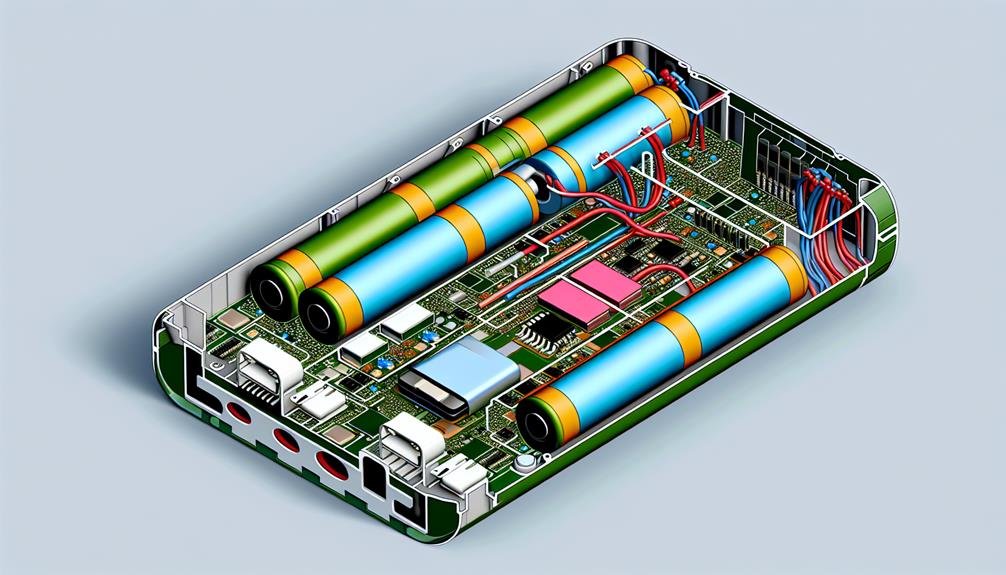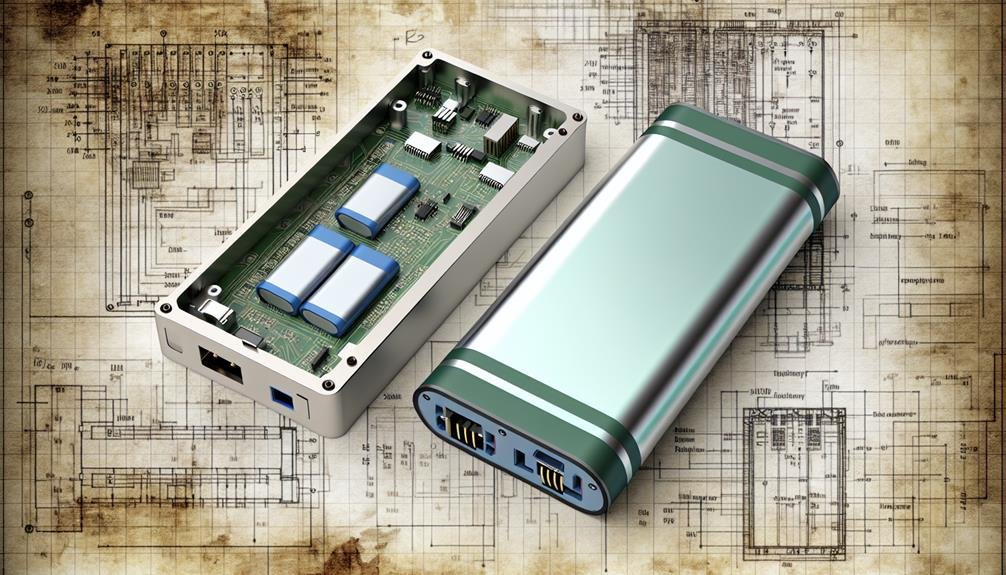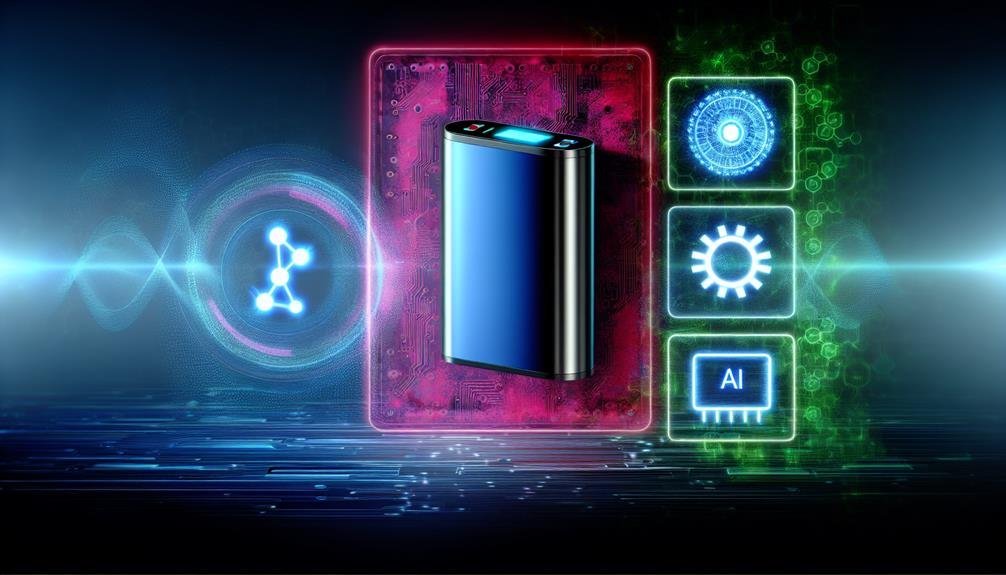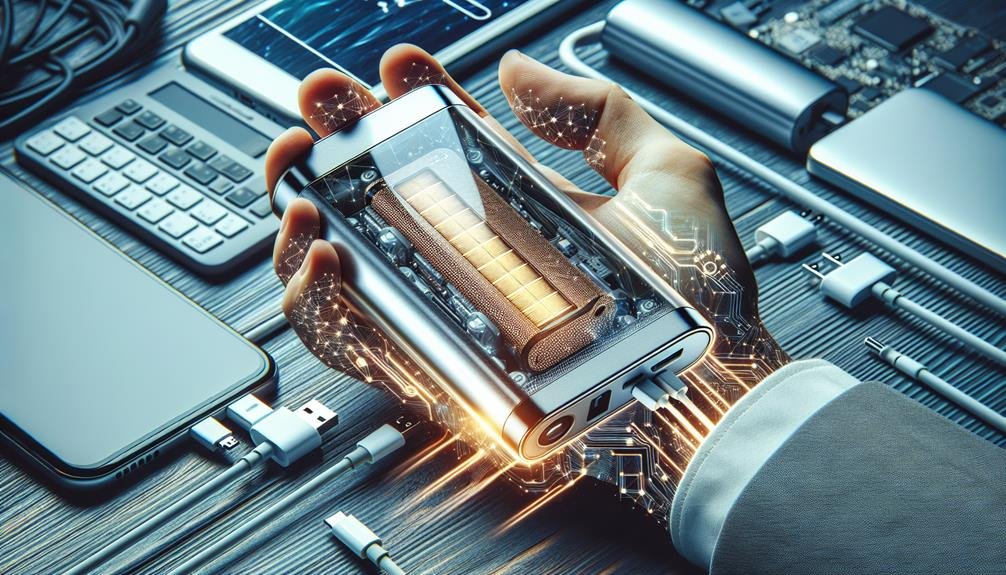Yes, most power banks are equipped with lithium-ion or lithium-polymer batteries due to their superior energy density and portability. Lithium-ion batteries are preferred for their high energy efficiency and rapid charging capabilities. In contrast, lithium-polymer batteries offer a lighter and more flexible alternative, though they require careful management to guarantee safety. Both types integrate safety mechanisms, such as overcharge and short-circuit protection, to maximize lifespan and prevent hazards. Choosing the right type can depend on your specific needs and preferences. For a deeper understanding of the differences and benefits, continue exploring.
What Are Power Banks?

Power banks, also known as portable chargers, are compact devices designed to store electrical energy and conveniently recharge various electronic gadgets on the go. These units provide a reliable source of portable charging, guaranteeing your devices remain operational even when you're away from a traditional power outlet.
When evaluating a power bank, one of the primary specifications to take into account is battery capacity, typically measured in milliampere-hours (mAh). The battery capacity directly correlates with the number of charges it can provide to your devices. For instance, a power bank with a higher mAh rating can recharge a smartphone multiple times before needing a recharge itself.
It's essential to match the power bank's battery capacity with your specific needs. If you're using it for a high-demand device like a tablet or laptop, you'll want a higher capacity to ensure adequate power supply. Additionally, verify that the power bank's output voltage and current align with your devices' requirements to avoid potential damage or inefficient charging.
Safety is paramount when using power banks. Always opt for units with overcharge protection, short circuit protection, and temperature control to minimize risks and maximize the lifespan of both the power bank and your electronic devices.
Types of Power Bank Batteries
When it comes to the types of batteries used in power banks, you'll primarily encounter lithium-ion (Li-ion) and lithium-polymer (Li-Po) varieties, each with distinct characteristics and advantages. Li-ion batteries are known for their high battery capacity, meaning they can store a large amount of energy in a relatively compact and lightweight package. This makes them ideal for power banks that need to provide extended usage times. Additionally, Li-ion batteries support rapid charging, enabling you to swiftly recharge your devices and the power bank itself.
On the other hand, Li-Po batteries offer a different set of benefits. They are generally lighter and can be shaped more flexibly, allowing for innovative power bank designs that are both slim and easy to carry. While Li-Po batteries may not always match Li-ion batteries in terms of battery capacity, they can still deliver reliable performance and are less prone to leakage, enhancing safety. Li-Po batteries also support rapid charging, although they may require specific charging protocols to guarantee both speed and safety.
Understanding the distinctions between Li-ion and Li-Po batteries can help you make an informed choice, prioritizing either battery capacity or form factor based on your specific needs and safety considerations.
Lithium-Ion Batteries Explained

You'll find that lithium-ion batteries are fundamental to modern power banks due to their superior energy density and efficiency. Understanding their battery chemistry involves examining the movement of lithium ions between the anode and cathode during charging and discharging cycles. This charge cycle process is critical for maintaining battery longevity and performance, directly impacting how effectively your power bank functions.
Battery Chemistry Overview
Understanding the intricacies of lithium-ion battery chemistry is necessary for grasping how power banks efficiently store and deliver energy. Unlike nickel cadmium cells and lead acid batteries, lithium-ion batteries provide superior energy density and lighter weight, making them ideal for portable applications. The core of a lithium-ion battery comprises a lithium-based cathode, a carbon-based anode, an electrolyte facilitating ion transport, and a separator to prevent short-circuits.
When you use a power bank, lithium ions move from the anode to the cathode through the electrolyte, generating an electric current. This process is reversible; during charging, ions migrate back to the anode. The electrolyte, often a lithium salt dissolved in organic solvents, ensures effective ion flow while maintaining safety.
Lithium-ion batteries also feature built-in safety mechanisms like thermal fuses and pressure-sensitive vents to mitigate risks of overheating and overcharging. The cathode materials, typically lithium cobalt oxide or lithium iron phosphate, directly influence the battery's voltage and capacity.
Understanding these components and their interactions is important for appreciating the reliability and efficiency of your power bank. Always handle lithium-ion batteries with care, as improper usage can lead to thermal runaway or other hazardous conditions.
Charge Cycle Process
The charge cycle process in lithium-ion batteries is a critical factor that determines their longevity and efficiency, involving the intricate movement of lithium ions between the anode and cathode. This process directly impacts the battery lifespan and its maintenance requirements. A single charge cycle is defined as the full discharge and recharge of the battery, and understanding how this cycle affects the battery's overall charging efficiency and performance is crucial.
During charging, lithium ions move from the cathode to the anode, and during discharging, they travel back to the cathode. This repetitive movement can lead to wear and tear over time, affecting the battery's effectiveness.
To maintain the battery's lifespan and performance at its best, consider the following:
- Avoid extreme temperatures: Both high and low temperatures can significantly reduce battery efficiency and lifespan.
- Partial charging: Regularly charging your battery to 80% rather than 100% can prolong its life.
- Avoid deep discharges: Frequently allowing the battery to drain completely can shorten its lifespan.
- Monitor charging cycles: Keeping track of charge cycles aids in timely maintenance and replacement.
Lithium-Polymer Batteries Explained
One type of battery commonly found in power banks is the lithium-polymer (Li-Po) battery, known for its lightweight, flexible form factor and high energy density. This battery technology offers advantages in energy storage, making it a popular choice for portable devices. Li-Po batteries use a polymer electrolyte instead of a liquid one, which allows them to be molded into various shapes and sizes, enhancing design flexibility and space utilization.
Li-Po batteries are constructed with multiple layers of polymer composites, providing high energy density and stable discharge characteristics. However, they require precise management to ensure safety, as improper handling can lead to overheating or even combustion. Adhering to manufacturer guidelines for charging and discharging is essential.
Here's a detailed comparison table to illustrate key aspects:
| Feature | Lithium-Polymer (Li-Po) | Description |
|---|---|---|
| Energy Density | High | Efficient energy storage in compact size |
| Weight | Lightweight | Ideal for portable applications |
| Form Factor | Flexible | Can be shaped to fit various designs |
| Safety | Requires careful management | Risk of overheating if mishandled |
| Electrolyte | Polymer-based | Different from liquid-based Li-Ion |
Comparing Lithium-Ion and Lithium-Polymer

When comparing lithium-ion (Li-Ion) and lithium-polymer (Li-Po) batteries, it's important to examine their distinct characteristics regarding energy density, form factor, weight, and safety. Both types of batteries are prevalent in modern power banks, but they exhibit notable performance differences.
Li-Ion batteries generally offer higher energy density, meaning they can store more energy in the same volume, enhancing power bank efficiency. Conversely, Li-Po batteries, with their flexible form factor, can be molded into various shapes, making them ideal for sleek, compact designs. Here's a breakdown to help visualize the comparison:
- Energy Density: Li-Ion batteries tend to have higher energy density, translating to longer usage times.
- Form Factor: Li-Po batteries are more adaptable, allowing for innovative and space-saving designs.
- Weight: Li-Ion batteries are often heavier, while Li-Po batteries are lighter, contributing to portability.
- Safety: Li-Po batteries are generally considered safer due to their solid electrolyte, but both types require proper handling to avoid risks.
In terms of battery technology, understanding these differences allows you to make an informed decision for efficient power bank performance and safety. Whether prioritizing energy capacity or design flexibility, both Li-Ion and Li-Po batteries have their own advantages tailored to different needs.
Why Lithium Batteries?
Given the distinct advantages of both Li-Ion and Li-Po batteries, understanding why lithium batteries dominate the power bank market reveals their superior energy efficiency, portability, and reliability. Lithium batteries offer a higher energy density compared to alternatives, allowing power banks to store more power in a compact form factor. This higher energy density directly translates to longer device runtimes, which is crucial for your mobile lifestyle.
Moreover, lithium batteries benefit from a lower self-discharge rate, meaning they retain charge for extended periods when not in use. This is particularly advantageous for power banks, ensuring they remain ready for emergencies. Additionally, the lightweight nature of lithium batteries enhances portability, making them the ideal choice for on-the-go power solutions.
However, it's important to recognize the disadvantages as well. Lithium batteries can be more expensive to manufacture, impacting the overall cost of power banks. They also require sophisticated protective circuitry to prevent overcharging and overheating, which adds to the complexity and price.
Despite these drawbacks, the advantages of lithium batteries—such as their energy efficiency and reliability—make them the preferred choice in power banks. By understanding these factors, you can appreciate why lithium technology remains dominant in powering your essential devices.
Safety Features in Lithium Batteries

Ensuring the safe operation of lithium batteries in power banks involves incorporating advanced safety features such as overcharge protection, thermal regulation, and short-circuit prevention. These features are critical in mitigating risks associated with thermal runaway, overcharging, and short circuits, which can lead to hazardous situations.
Modern power banks utilize several sophisticated mechanisms to enhance safety:
- Overcharge Protection: Prevents the battery from receiving more charge than its capacity, thereby reducing the risk of overheating and potential fires.
- Thermal Regulation: Employs sensors to monitor temperature, ensuring the battery remains within safe operating limits and preventing thermal runaway.
- Short-Circuit Prevention: Detects and interrupts abnormal current flow to avert potential damage and hazards.
- Over-Discharge Protection: Safeguards the battery by stopping discharge before it depletes to a critical level, maintaining optimal battery health and safety.
Longevity and Durability
To optimize the longevity and durability of power banks, understanding the impact of charge cycles, environmental conditions, and the quality of lithium-ion cells used is essential. Battery life is significantly influenced by your charging habits. For example, regular full discharges and overcharging can deteriorate the cells faster. Aim to maintain the charge level between 20% and 80% to extend lifespan. Additionally, high temperatures can hasten cell degradation, so avoid exposing your power bank to direct sunlight or leaving it in hot environments.
The durability of a power bank also heavily relies on the quality of the lithium-ion cells. Premium cells offer better efficiency and longevity, reducing the need for frequent replacements. This not only prolongs battery life but also minimizes the impact on the environment. Proper disposal options should be considered when a power bank reaches the end of its useful life. Lithium batteries contain hazardous materials that can be harmful if not handled correctly. Many localities offer recycling programs specifically tailored for electronic waste, ensuring safe and responsible disposal.
Future of Power Bank Technology

As the demand for more efficient and longer-lasting power solutions continues to rise, the future of power bank technology is set to be shaped by cutting-edge advancements in battery chemistry, energy density, and smart charging capabilities. Key trends will redefine how you interact with power banks, enhancing both convenience and safety.
- Wireless Charging: Say goodbye to tangled cords. Future power banks will increasingly support wireless charging, enabling seamless energy transfer without physical connections.
- Solar Power Integration: Imagine harnessing the sun's energy. Solar-powered power banks will offer an eco-friendly alternative, allowing you to recharge devices even in remote locations.
- Advanced Battery Chemistry: Expect longer life cycles and faster charging times. Innovations in battery materials, such as solid-state batteries, will provide greater energy density and improved safety features.
- Smart Charging Capabilities: Intelligent systems will optimize charging efficiency. These power banks will automatically adjust output based on the connected device's requirements, minimizing overheating risks.
These developments guarantee that future power banks not only offer better performance but also prioritize safety. Enhanced energy management systems will mitigate overheating and overcharging, addressing the critical need for reliability. As these technologies evolve, you'll find power banks becoming indispensable tools for daily life and emergency preparedness.
Frequently Asked Questions
How Do I Properly Dispose of a Used Power Bank?
Imagine Sarah, who responsibly recycles electronics. You should drop your power bank at designated e-waste centers. Recycling options minimize environmental impact and guarantee safe disposal, reducing hazardous materials from contaminating landfills. Prioritize safety and sustainability.
Can Power Banks Charge Multiple Devices Simultaneously?
Yes, power banks can charge multiple devices simultaneously, but you should consider charging efficiency and potential compatibility issues. Confirm your power bank supports the required output for each device to maintain safety and peak performance.
Are There Eco-Friendly Alternatives to Lithium Battery Power Banks?
Investigate the theory that sustainable options exist for power banks. Indeed, there are alternatives like supercapacitors and biodegradable batteries. These solutions reduce environmental impact, offering eco-friendly power storage without sacrificing safety or performance.
What Power Bank Capacity Is Suitable for My Smartphone?
To determine a suitable power bank capacity, consider your smartphone's battery lifespan and charging speed. A power bank with a capacity of at least 10,000mAh guarantees multiple charges, maintaining safety and efficiency in emergency situations.
How Long Does It Take to Fully Charge a Power Bank?
While fast charging technologies shorten smartphone charging, power bank charging time estimation varies. It depends on the power bank's capacity and input power. Typically, it takes 2-8 hours. Always use certified chargers for safety and efficiency.



